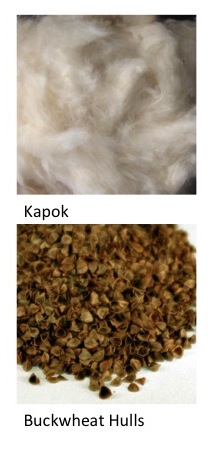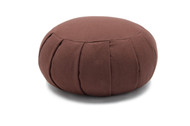Which Type of Meditation Cushion Fill is Best, Kapok or Buckwheat Hulls?
Posted by Jay Suthers on Jul 21st, 2022

Our customers oftentimes contact us with questions about which meditation cushion is best for them. We offer different shapes and sizes but the question of which type of fill to choose comes up often. Many of our sitting meditation cushions are available with both kapok and buckwheat hull fill materials and each material offers distinct pros and cons.
Kapok has been the traditional fill for Zafu meditation cushions for thousands of years. It is a fluffy, cotton-like material that comes from the Kapok trees of Mexico, Central America, Northern South America, and parts of Asia and West Africa. The Kapok trees grow enormous seed pods that, when mature, burst open to reveal the downy material laden with tiny seeds. The wind catches the fluff and carries the seeds for miles. Think of milkweed pods but on a much larger scale.
Buckwheat Hulls are the outer shell of the
buckwheat grain. These shells are the inedible part of the buckwheat grain and would otherwise be useless if not used to fill pillows and cushions. Each shell is cup-shaped, which creates space between the hulls. The loose, sand-like, consistency of the hulls make for a soft, flowing fill material.
Both Kapok and Buckwheat Hulls make a great fill material for all kinds of cushions, pillows, and mats. Kapok has been used for floatation devices on boats. It is naturally water resistant and, therefore, traps air in the space between the fibers making it buoyant. Buckwheat hulls have used to fill sleeping pillows some decades ago but most people found this to be a fad.
Buckwheat Hulls became a popular fill for the Zafu and other meditation cushions back in the 70s. It was discovered that buckwheat hulls conform well to the shape of the body resulting in a comfortable and stable cushion for meditation. It is similar to sitting in a mound of sand at the beach and, therefore, can provide a grounded feel.
Here is a list of some of the pros and cons for each type of fill:
Kapok
Pros
- It's the traditional fill for meditation cushions and has been used for thousands of years.
- Because of its cotton-like nature, it feels softer than buckwheat hulls.
- Though kapok cushions can flatten with use, they can be revived by squeezing and fluffing up the cushion. This will also restore lift.
- Kapok is light weight (about half the weight by volume) compared to Buckwheat Hulls.
- Kapok is naturally organic requiring no pesticides or herbicides to grow.
Cons
- The level of kapok cannot easily be adjusted - the fibers are blown into the cushion. Removing kapok from a cushion is not recommended and stuffing more kapok into the cushion manually can result in a lumpy cushion with a "Cottage Cheese" look and feel to it.
- Kapok has a spongy but firm feel to it. However, when it is new it can be somewhat like sitting on a ball and feel a bit roly poly or wobbly. With use, however, the kapok cushion will flatten and feel perfectly stable.
- Restuffing a kapok cushion generally requires professional equipment - using a yard stick or long wooden dowel will result in uneven areas and lumps.
- Over time the Kapok cushion will flatten and may need to be restuffed. As previously stated, adding Kapok to a flat cushion is difficult and has mixed results.
Buckwheat Hulls
Pros
- Especially with Sage Meditation's Zafus and other meditation cushions, the Buckwheat Hull cushions are adjustable. They each have a zippered opening, which we use to fill the cushions. This opening will allow you to remove and re-add buckwheat hulls to adjust the height and comfort of the cushion.
- Buckwheat hulls conform to the shape of the body and provide a grounded feel.
- Buckwheat hull cushions do not flatten or require fluffing up.
- Buckwheat is naturally organic requiring no pesticides or herbicides to grow.
Cons
- Some customers find Buckwheat Hull cushions to be a bit hard. Just like sitting on sand, it can be a firm surface if you don't have some of your own natural cushioning "down there".
- Buckwheat Hulls make a bit of a scrunching sound when you move around on them.
- Buckwheat Hull cushions weigh about twice as much as kapok cushions.
- The hulls break down after awhile, but are easy to replace or add to through the zippered opening. This break down can produce some brown dust particles.
Bugs and Small Animals
Both cushions are resistant to bug infestations. There is no food value in either the Kapok fibers or the Buckwheat Hulls. They both create a dry and inhospitable environment for insects. Rodents find the kapok fibers irritating and the buckwheat hulls are inedible and too hard to chew. It is important to keep the cushions in a dry, clean environment so as not to invite insects and small animals making a home in the meditation cushion. If the cushion will not be used for a long period of time, it is best to put the cushion in a plastic bag to keep it dry and cool.
Buckwheat Hull cushions have become increasingly more popular. More than 80% of the Zafu and Cosmic Cushion orders from our customers are for Buckwheat Hull fill. The customers who choose Kapok typically choose this product because they want the traditional cushion. Others have chosen the Kapok because it is a bit more soft to the touch. Again, Kapok is also lighter, which makes it somewhat easier to carry around.
It is best if you can test a few cushions locally before making a purchase, but we stand by our
30-day return policy. We want you to have the best cushion for your need. You will only know which type of fill is going to work for you when you are able to sit on the meditation cushion.
I hope this information has been helpful.
Thank you for reading,
Jay
If you would like to comment on this blog or have any questions, please feel free to
Contact Sage Meditation Customer Service.

